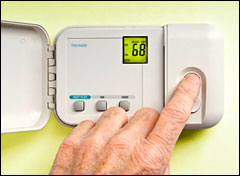Dear Umbra,
Many of my friends are environmentally minded and do lots of things to try to have a smaller carbon footprint. Yet when I tell people I turn my heat down when I leave the house even for an hour or two, and that I turn it down to 50 at night, they say, “I thought it takes more energy to reheat the house than to keep it at a constant temperature.” Please clarify. If it is better to turn the heat down, then there is a LOT of room for education on this topic, as even many people in the environmental community are confused.
Sarah W.
Brunswick, Maine
Dearest Sarah,
Either by evoking the confused masses or using all caps, you have convinced me to revisit this topic. I will try to explain, in basic terms, just why we should turn down the thermostat. But let me be crystal clear up here in the thesis paragraph: Turn down the thermostat at night and before you leave the house.

Get with the program.
Let’s say a typical, nice heat setting is 68 Fahrenheit while at home, 58 at night or while away. (Your 50 is probably lower than most people will try, but bravo to you.) The heater will save fuel as it falls to 58, and expend about the same amount of fuel as it rises back to 68. Therefore, these two transitional phases cancel each other out. And while the heater is set at 58, for as long as it is set at 58, it is merrily saving fuel (aka energy, money, and the planet). Because as we all know, it takes more heat to keep a house at 68 than at 58. Overall, then, fuel is saved.
To bulk up this answer a little bit and remind us all that insulation and sealing the house are important aspects of keeping ourselves, but not the planet, warm, let’s discuss air-movement dynamics briefly. Remember, air lives a life of heat equality. Hot air wants to rush out and share the heat with nearby cold air until all air is the same temperature. This happens, as fervid readers may recall, through the processes of convection, radiation, and conduction. The stack effect is an example of convection: Hot air in a building not only rises, but is of higher pressure. As it rises, it pushes against any cracks in the ceiling or roof, escapes, and leaves a low-pressure area at the bottom of the house. The cold air rushes in to the low-pressure area, and must in turn be heated.
Our heaters are fighting an incessant battle on our behalf, warming all the new air. If we are not there to be warmed, or are sleeping under a cozy duvet, we can turn down the thermostat. Programmable thermostats are very helpful and quite cheap.
I repeat: Reheating uses less energy than keeping it hot while you’re gone. No organization — reputable or disreputable — disagrees with this advice. To quote the EERE, “This misconception has been dispelled by years of research and numerous studies.”
People, turn your thermostats down.
Incessantly,
Umbra



